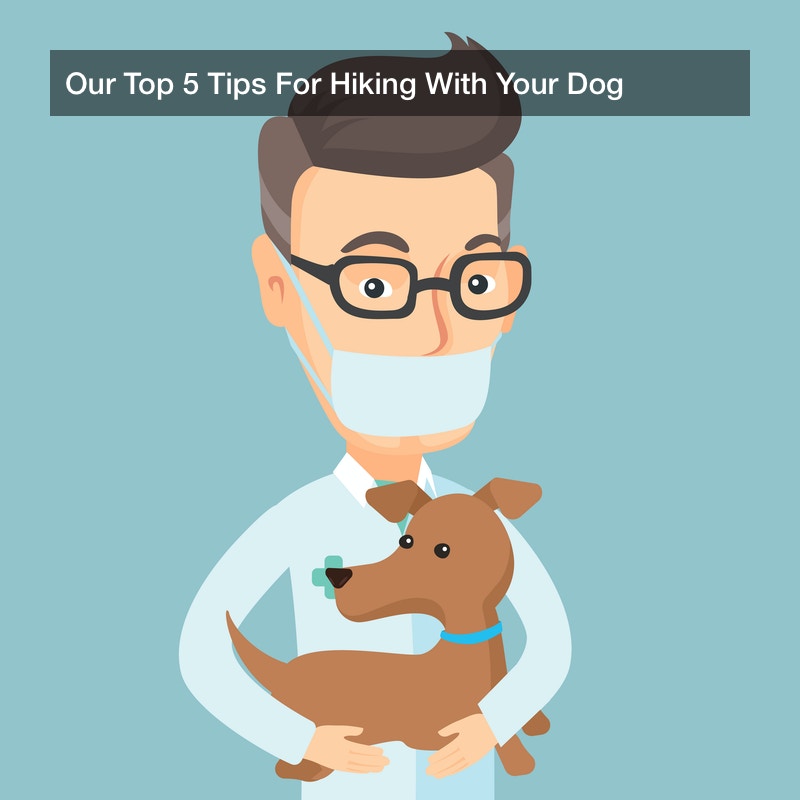
We all want to spend as much time as possible with our dogs. Dogs are more than just pets — they’re truly man’s best friend. Of course, for those who require the help of service dogs, it can literally be impossible to get through a lot of daily tasks without a dog. Whether you want to kill time with your dog or need your dog for help, you may have toyed with the idea of taking them on a hike from time to time. After all, hiking can be difficult and certainly boring to do on your own.
On paper, your dog may seem like the perfect hiking buddy. Your dog won’t turn back and ditch you because they’re tired of the trail. Your dog won’t stop to take pictures of something you really don’t care about, either. However, just as there are certain things you need to be aware of for your own safety when hiking, you’ll always want to be aware of certain things that could be dangerous for your dog — and many of the hiking safety tips that apply to your dog can also apply to you.
We don’t want to scare you off of hiking, of course. There are plenty of health benefits that come with hiking, and if you follow your hiking safety tips to the letter you should be fine, as your dog. It’s a great way to get fit, providing not only the opportunity for cardio training, but the ability to build and tone muscle as well. Hiking is also a healthy habit — over time, you’ll build up endorphins when hiking, and get a natural high from the experience. Hiking is also just a fantastic way to spend your time in general. Our National Park system offers over 18,000 miles of hiking trails, which range from short jogging trails to long hiking trails. But nonetheless, there are risks that come with hiking, and when you’re hiking with your dog you need to be concerned for their safety as much as yours. If you prepare for hiking — not just physically but mentally, as well — you’ll be much safer, and able to fully take advantage of this fun hobby without as much risk. With that being said, we’re going to look into some of the hiking safety tips that will keep both you and your pup from getting hurt.

1. Pay Attention To Symptoms
Once you’ve really started on a hike, it’s easy to get into the mindset that you must finish it. It’s easy to ignore symptoms that could be warning you of a growing injury or illness. However, you may not expect to miss your dog’s symptoms. Think about it: do our dogs really let us know when they’re not feeling well? It’s more on us to keep an eye on them, as many dogs silently suffer instead of whining. One of the first signs that something is wrong, of course, is difficulty breathing. Keeping an eye on your breathing is perhaps one of the easiest hiking safety tips that you can follow. You’ll notice difficulty breathing in yourself easily enough — in your dog, it might initially be harder to tell the difference between panting and truly labored breathing. Therefore, you might want to be overcautious and simply bring your dog to stop if the two of you start to struggle with your breathing. Foot pain is another sign that you need to slow up and relax. Don’t feel as if you need to push yourself. Remember that when it’s time to return back to your car, you’ll have to turn around and walk back — the last thing you want is to render yourself or your dog incapable of walking. Of course, if your dog is favoring a leg, this can be a sign of serious trouble. Carefully examine whichever foot your dog is favoring for debris, like thorns or rocks; but be prepared to carry your dog back down the trail, if they can’t move easily on their own. With that being said, you’ll want to prepare more for longer trails. If you haven’t had a health screen been to visit a chiropractor in a while, schedule things like that before your hike — and do the same for your dog if they’re due for a vet visit. If you haven’t already, you may want to look into health insurance for pets, which can help offset the costs of your dog’s vet visit. Ultimately, what troubles a person is also likely to trouble a dog. You need to be vigilant regarding your health and theirs — this is easily one of the most important hiking safety tips for you to remember.

2. Bring Food And Water
Not all hiking safety tips are so easy to follow. It may be tempting — especially if your hiking trail seems relatively short — to skip the snacks and focus on keeping your pack light. However, it would be a mistake to skimp on food and water to lighten the load. If you’re traveling with your dog, you essentially need to take double the water you would if you were hiking alone. They need to stay just as hydrated as you. Although your dog’s meal schedule may differ from your own, it’s a good idea to bring some dog food as well, just in case your dog needs to recharge along the trail. There are certain types of foods and drinks, of course, that offer an extra energy boost — without relying upon sugar. Try to incorporate those into your hiking plan. The worst thing you can do is let yourself get drained halfway through the hike, and dehydration is a real killer. Keep in mind that you don’t have to rely upon yourself to carry these items alone. Many larger dogs — and especially service dogs — like carrying food and water through packs on their backs. It gives them a job to do, which is great for task-oriented dogs; and in this case, it can help both of you in a very real way.

3. Brush Up On Your Survival Skills
You never know when you’re going to find yourself lost, without an easily reached cell phone signal. With that being said, if the worst case scenario happens and you find yourself lost on the trail, don’t panic. Look on the bright side — chances are that you’re much safer with your dog than you would be alone. If you keep your wits about you and remain calm, the two of you should make it home safely. It’s true that much of what you can do to stay safe if lost on a hiking trail is preventative. As previously discussed in our other hiking safety tips, you should bring food and water — provisions for if you find yourself lost — along with a small tent if possible. Many of us are accustomed to relying upon our phones and their GPS systems for directions, but you should bring a paper map along as well. Of course, a map is much less use if you don’t know how to use it properly. Familiarize yourself with the area and terrain. Know the visual landmarks you can rely upon for direction. And obviously, make sure that you can read a map on your own! It may surprise you to find that many of the most basic hiking safety tips come back to the idea of being self reliant. You’ll want to stay in one place if you get lost. Should a search party be sent after you, it’s best that you’re easy to find. Make sure that your dog is under careful supervision, and doesn’t get away from you — a nervous dog could potentially draw the attention of unwanted predators. Stay vigilant, and pay attention to what you see and here. Furthermore, you shouldn’t over-use your phone, as well as any other battery-reliant tools you bring along, like flashlights. Hopefully, you’ll be found sooner rather than later, but you don’t want to expend your battery too quickly. You may very well want to bring a water purifier with you, particularly a reusable one. That way, should you run out of the water you bring along, you can purify water nearby. This is important not only for you, but for your dog. Before you fully dedicate yourself to your hike, of course, you should also familiarize yourself with edible flowers and plants. These may vary depending on where you live, but knowing which ones can be trusted means that you can have an additional food source should you get lost. Many foods that we can eat, however, are not good for our dogs. Therefore, you should double check your research before you hit the trail — make sure that the hiking safety tips you file away in your mind apply to both yourself and your dog.
4. Follow The Rules
This may seem obvious enough — but follow the rules of the area that you’re hiking in! Don’t go off the trail, and respect safety barriers. Many hikers get in trouble because they decide to go off trail, or ignore warning signs. You may feel even more confident if you’re hiking with your dog. The fact is that hiking with your dog means that you’re responsible for more than just your own life — and even if you want to endanger your own life, you need to keep your dog’s in mind as well. Furthermore, you need to keep in mind that there can be legal repercussions to leaving a hiking trail, especially if you end up trespassing on private property. Certain parks also have areas where dogs are allowed, and areas where they are not allowed; keep that in mind, and follow the necessary guidelines. It may seem like many of the most important hiking safety tips involve thinking ahead — but that’s because it’s one of the most crucial things a hiker can do. Common sense is key.

5. Don’t Forget The Weather
When it comes to key hiking safety tips, there is one more that you shouldn’t forget. You need to check the weather before you go hiking. Not only do you need to make sure that you aren’t taking your dog out in weather that is too hot — which could end up causing the two of you to become dehydrated — or too cold; you also need to keep an eye out for any storms that could occur. Getting caught in the rain may not seem like too much of an issue. However, if you’re out hiking you could end up caught in a mudslide, or flooding. Depending on your dog, a storm could also cause panic and anxiety in the animal, leading you into disaster. While it’s impossible to know exactly what kind of weather you’ll be dealing with during your hike, it’s better to know as much as you possibly can ahead of time.
Following hiking safety tips may seem to take some of the spontaneity out of your hike. But you and your dog are better off safe than sorry. Don’t risk your lives to save time when preparing for your hike. Indeed, you should also remember that not all dogs are ideal hiking buddies, due to their temperaments, breeds, or both. Be straightforward and vigilant — and ultimately, you’ll be able to have a fun hike!

